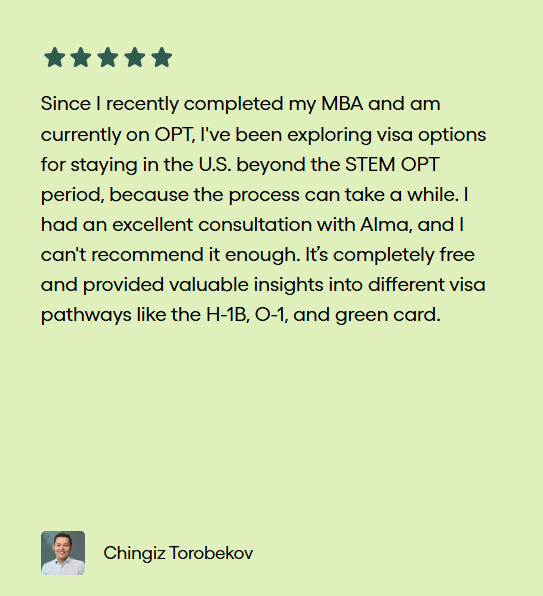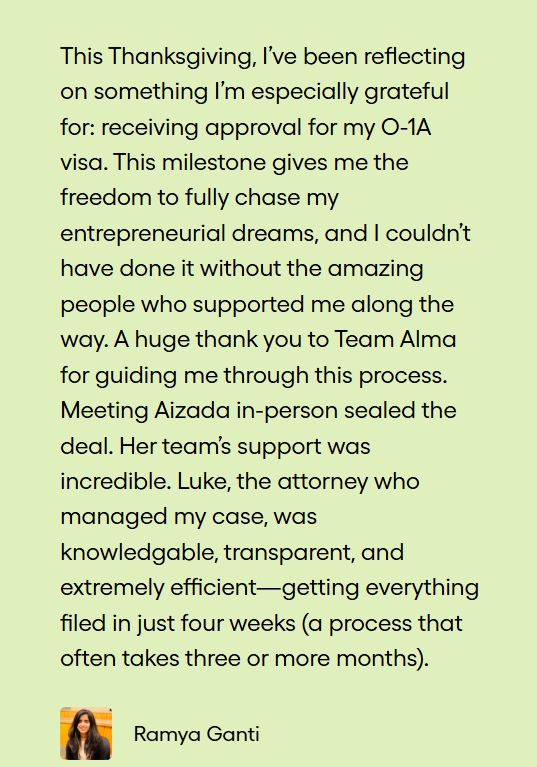- Filing fees and other administrative costs for an O-1 visa are relatively fixed.
- Legal representation is often the biggest, and least standardized expense, so it’s important to understand how those fees are structured.
- Alma charges a flat fee with no hidden costs.
O-1 visa application costs range from about $8,000 to over $10,000, depending on the legal services you choose and whether you opt for expedited processing.
We provide a more detailed breakdown in the article below, but the cost of an O-1 visa generally includes:
- U.S. Citizenship and Immigration Services (USCIS) filing fees, including for dependents
- Consulate and U.S. embassy fees
- A USCIS premium processing fee (optional)
- Legal and attorney fees, which vary depending on the law firm you hire
Many immigration law firms offer flat pricing, but some don't disclose all their fees upfront or charge extra for actions like responding to Requests for Evidence (RFEs), making it difficult to know what you’ll ultimately pay.
Timelines are another cost factor, as delays can create opportunity costs such as missed business opportunities or the stress of legal uncertainty. Processing time depends on how long it takes to prepare the application and whether USCIS issues an RFE or a denial requiring refiling.
For instance, some of our clients who previously worked with other firms reported timelines of four to seven months from filing a petition to receiving a final decision.
Alma simplifies both the O-1 application process and pricing by offering one flat fee that covers your entire application process, including responses to RFEs and refiling if needed. There are no surprise charges or added costs.
We secure a USCIS decision within four to six weeks (well below the standard USCIS processing time of four to six months), with a 99% approval rate that reflects the strength of our petitions.
Learn more about Alma’s O-1 process and how we make costs and timelines transparent from day one.
How Much Will You Pay for an O-1 Visa?
Total costs for an O-1 visa application include USCIS filing fees, consulate or U.S. embassy fees, and attorney fees, which are the largest and most variable part of the process.
USCIS Filing Fees for the O-1 Visa
The following visa application fees are directly payable to USCIS:
Consulate or U.S. Embassy Costs
Applicants must pay a separate fee to the U.S. Department of State for a visa interview at a U.S. consulate or embassy, which is typically $185 (varies by consulate).
Visa reciprocity fees might also apply (varies from country to country).
Attorney and Legal Fees
Although you could theoretically prepare and send the application yourself, for USCIS filings, it's advisable that an attorney do so since:
- Attorneys know how to match your achievements to the complex O-1 visa criteria and USCIS standards.
- They frame and organize supporting evidence for applications, often running 500–700 pages, into a persuasive legal argument that highlights extraordinary ability.
Skilled and experienced immigration lawyers increase the likelihood of approval by ensuring your petition is both complete and strategically positioned for USCIS review.
Legal advice for O-1 applications is typically the largest and most variable part of the total cost, as firms aren’t fully transparent about what their fees cover. Some advertise a flat legal fee but exclude important services — like responding to an RFE or refiling in case of denial — for which they charge significantly more.
Such firms may offer a partial refund if an application is denied, but then submit a low-quality petition that fails to demonstrate extraordinary ability, often triggering an RFE or denial. The added cost of paying them again to respond or refile can quickly outweigh the refund, leaving applicants spending more than they anticipated.
It's for this reason that Alma offers one flat fee of $8,000, which includes responses to RFEs and refiling your petition in cases of denial.
Our immigration lawyers have successfully handled some of the most complex O-1 cases in the field and excel at compiling and presenting evidence that demonstrates extraordinary ability.
At Alma, we focus on building a strong petition from the outset, offering:
- A tailored checklist to guide you through every USCIS criterion, paired with an expert review of your dossier to avoid pitfalls like incomplete supporting documents, which can cause delays.
- An average two-week turnaround time from when you provide supporting documents to when your O-1 application is filed.
- USCIS premium processing to secure a response within 15 business days.
- An in-house portal for tracking your application status and receiving automatic notifications and updates, eliminating the usual back-and-forth messaging.
- A designated, responsive attorney (rather than a paralegal) with at least 10 years’ experience in immigration law and preparing work visas, to whom you have direct email and phone access to ensure alignment throughout the process.
Start building a stronger O-1 petition with Alma’s experienced immigration lawyers.

What Does the O-1 Application Involve?
Applying for the O-1 starts with drafting a legal narrative and opinion, and compiling evidence of your background and extraordinary ability in:
- The sciences, education, business, or athletics (for the O-1A visa)
- The arts, motion picture, or television industry (for the O-1B visa)
For the O-1A, we recommend demonstrating a distinguished reputation and meeting at least three of the eight eligibility criteria set by USCIS.
Deciding whether to pursue an O-1 visa comes down to whether you’re willing to invest in staying where your work is — or where it should be. The O-1 gives you flexibility and control over that investment, a benefit many other U.S. visas don’t provide.
Unlike the H-1B visa, an O-1 status is not tied to a lottery system or annual caps. Instead, it’s based on extraordinary achievement, supported by evidence of your publications, awards, leadership, press coverage, high salary, and other achievements that demonstrate a distinguished reputation.
An O-1 status can bring long-term stability since many O-1 visa holders go on to apply for a Green Card through categories like the EB-1A or EB-2 NIW, making the upfront investment in an O-1 worthwhile for those seeking permanent residency.

Flat Fees, Faster Approvals, Full Transparency
Don’t wait months for a decision. Alma’s immigration lawyers, experienced across a variety of work visas, prepare and file your O-1 petition in as little as two weeks, with premium processing to ensure a USCIS response in just 15 business days.
Start your O-1 journey today with a free consultation.
Frequently Asked Questions
No, employers aren’t legally required to pay for the O-1 visa costs.
This differs from other employment-based visa categories, such as the H-1B visa, where employers have legal obligations regarding visa application fee payment. With an O-1 visa, there’s more flexibility regarding who covers the costs. The responsibility for payment can fall on the employer, an agent, or the beneficiary (the applicant) themselves.
While not legally mandated, many employers choose to cover part or all of the O-1 visa costs, especially if they’re invested in retaining the individual long-term. It’s worth asking your employer about potential reimbursement or cost-sharing options.
To recap: government filing fees (including premium processing) and attorney fees for an O-1 visa application can be paid by either the applicant or the employer.
No, an O-1 petition must be filed by a U.S. employer or agent on behalf of the foreign individual.
Here's a breakdown of who can sponsor an O-1 visa:
- A U.S. employer can file Form I-129, Petition for a Nonimmigrant Worker, on behalf of the applicant.
- A U.S. agent acting on behalf of a foreign employer can also file the petition. This is particularly relevant for startup founders, freelancers, or artists who often work through agents.
- The beneficiary's own U.S. company (in the case of entrepreneurs) can provide sponsorship. This typically involves forming a U.S. business entity (like a C-Corp or LLC) and setting up a genuine employer–employee relationship within the company, often with a board of directors that oversees the founder’s role.
Once an O-1 visa is approved, the O-1 visa holder can work only for their sponsoring employer or agent.
Yes, you can switch from an H-1B to an O-1 visa if you meet the O-1 visa's requirement for extraordinary achievement.
You may apply for a change of status with U.S. Citizenship and Immigration Services while remaining full-time in your H-1B status, or you can apply for the O-1 at a consulate abroad.
The O-1 visa requires demonstrating extraordinary achievement but offers advantages including flexibility, allowing the O-1 visa holder to work with multiple employers, start their own business, and potentially fast-track permanent residency through the EB-1 Green Card.





.png)
.png)


